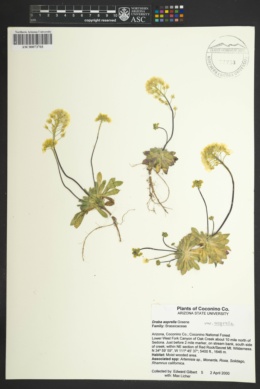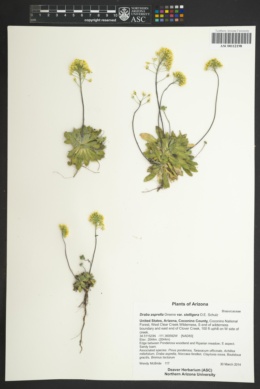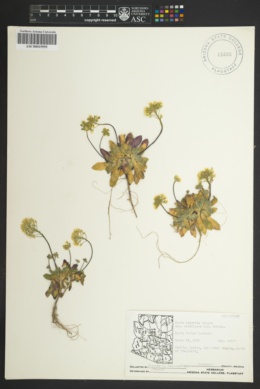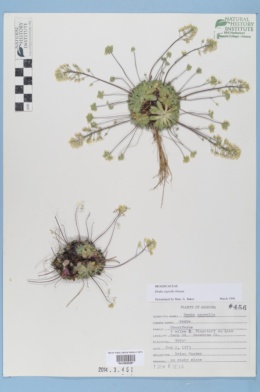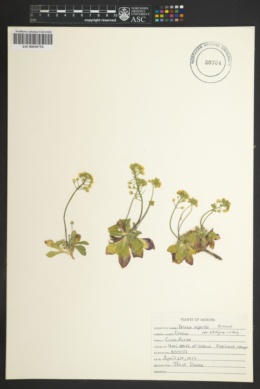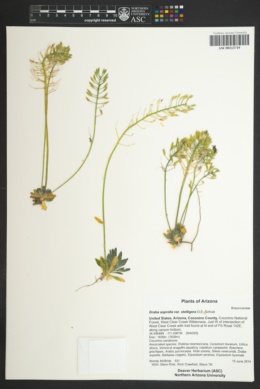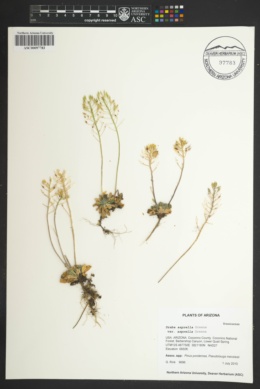Draba asprella
|
|
|
|
Family: Brassicaceae
rough draba, more...Rough Whitlow-Grass, rough Whitlowgrass
|
Perennials; (cespitose); caudex branched (with some persistent leaf bases); scapose. Stems unbranched, (0.4-)0.6-1.5(-2.7) dm, pubescent throughout, trichomes simple, 0.5-1.5 mm, and 2-4-rayed ones, 0.05-0.3 mm, (sometimes 2-4-rayed ones distally). Basal leaves rosulate; subsessile or shortly petiolate; petiole ciliate throughout; blade oblanceolate to spatulate or obovate, (0.6-) 0.8-4.5(-6) cm × 2-12(-16) mm, margins usually entire, rarely obscurely dentate, (not ciliate), surfaces abaxially pubescent with stalked, (2-)4-rayed trichomes, 0.2-1 mm, adaxially with stalked, 2-4-rayed trichomes, 0.3-0.8 mm, and simple ones, 0.5-1.9 mm. Cauline leaves 0. Racemes (15-)30-75-flowered, ebracteate, elongated in fruit; rachis not flexuous, pubescent, trichomes 2-4-rayed, sometimes with simple ones. Fruiting pedicels horizontal to divaricate-ascending, straight, 3-11(-16) mm, pubescent, trichomes 2-4-rayed, sometimes with simple ones. Flowers: sepals broadly ovate, 1.8-3.5 mm, pubescent, (trichomes simple and short-stalked, 2-4-rayed); petals pale yellow, oblan-ceolate, 4-7 × 1.5-2.5 mm; anthers ovate to oblong, 0.4-0.7 mm. Fruits ovoid-ellipsoid to oblong, plane, inflated basally, 3-8 × 1.8-3.5 mm; valves hirsute, trichomes simple and spurred, (0.2-)0.3-1 mm, or puberulent, trichomes short-stalked, 2-4-rayed, 0.1-0.2 mm; ovules 8-12(-18) per ovary; style 0.6-2(-2.5) mm. Seeds oblong, 0.9-1.2 × 0.6-0.8 mm. 2n = 30. Duration: Perennial Lifeform: Forb/Herb General: Perennial, densely tufted; stems 1 to many, scapose, 4-15 cm tall, erect to ascending, sometimes decumbent; herbage grayish pubescent with once-forked to unequally 4-rayed stellate hairs, and sometimes simple hairs; caudex branched. Leaves: Basal, forming a rosette, simple, ovate, narrowly oblong, to broadly oblanceolate, 0.8-4.5 cm long, 2-12 mm wide, succulent, pubescent with forked, stellate, and/or simple hairs, margins weakly toothed to entire, apex obtuse to rounded; blades petiolate. Flowers: Inflorescence a terminal raceme, elongating in fruit; pedicels spreading to ascending, 8-15 mm long; sepals narrowly oblong, 1.6-2.8 mm long; petals narrowly oblanceolate, 2-3 mm long, pale yellow to greenish yellow; flowers April-June. Fruits: Silicle, ovate-elliptic, (2.5) 3-7.5 mm long, 1.7-3.5 mm wide, not twisted, pubescent; mature style 0.7-1.7 mm long; seeds several. Ecology: Pine forests, shaded habitats, often in rich soils; 1500- 2400 m (5000-8000 ft); Apache, Cochise, Coconino, Graham, and Pinal counties; southwestern U.S. Notes: Three varieties occur within our region: var. asprella, var. kaibabensis, and var. stelligera, the latter of which is most common. Draba petrophila (Santa Rita Mountain whitlow-grass) forms basal rosettes of leaves, but is not densely tufted; stems are leafy, the herbage bright green, sparsely pubescent to nearly glabrous; basal leaves are oblanceolate, 3-8 cm long, 3-4 mm wide; cauline leaves are similar but reduced, with entire to sometimes dentate margins; petals are 3-4 mm long, yellow; siliques are elongate, usually twisted, glabrous to pubescent; mature style is 1-3 mm long. It occurs in montane habitats, often in rock crevices at 1200-2700 m (4000-9000 ft). Draba spectabilis (showy draba) is another perennial species in our area with basal rosettes that are not densely tufted and leafy stems; it has bright green herbage, basal and lower cauline leaves sparsely pubescent with appressed 4-rayed stellate hairs, 1.5-3 cm long and 3.5-8.5 mm wide, dentate or sometimes entire, and yellow petals 4-7 mm long. In our area it is found in upper montane habitats at 2800-3000 m (9200-9850 ft), only in the Chuska and Lukachukai mountains on the Navajo Reservation. Editor: Springer et al. 2008 |



































































